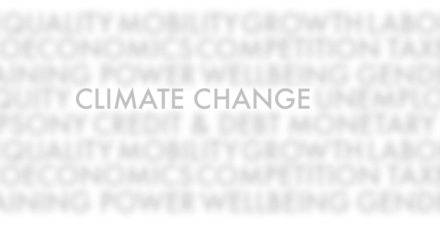Policy workshop addressed promises and challenges of using carbon pricing to combat climate change

Climate change might be the world’s most complex public policy problem. It is more global, more long-term, more irreversible, and more uncertain than most other policy challenges and probably unique in the combination of all four factors. Given this daunting mix, it is all too tempting to look for a simple fix.
Economists have long pointed to carbon pricing as just such a fix: Increase the price of carbon emissions and watch emissions decline. The theory is indeed compelling. In fact, it is based on the one and only law in all of economics—as the price of something goes up, the quantity demanded goes down.
The practice, alas, is not quite as simple. For one, there are other market failures and hurdles to overcome in transforming the world’s economies from their current high-carbon, low-efficiency path toward a low-carbon, high-efficiency one. Second, politics. Despite the ample warnings and evidence we have been receiving for decades, the United States and others have taken only modest steps to reducing carbon dioxide and other greenhouse gases that contribute to climate change.
To help provide a path forward for policymakers, Jesse Jenkins of Princeton University, Leah Stokes of the University of California, Santa Barbara, and I convened a virtual workshop of academic and policy experts in March 2020 to discuss the current state of policy in the United States and around the world. The discussions addressed such challenges as how to:
- Price carbon and establish a politically viable regimen to significantly reduce its use
- Allocate any revenues that might accrue from a carbon pricing policy, including addressing effects on low-income households and communities, as well as those economically dependent on the production or use of fossil fuels
- Make such policies fit in with measures that regulate emissions and fuel use
- Foster low-carbon innovation
The participants included economists, political scientists, energy and innovation experts, lawyers, and leaders and experts from government agencies, nongovernmental organizations, foundations, and advocacy groups. More than 70 individuals gathered online to help make the workshop a success.
The convening was made possible by financial support from the William and Flora Hewlett Foundation, the Alfred P. Sloan Foundation, the Washington Center for Equitable Growth, and the Niskanen Center, and it was hosted and facilitated by New York University’s Robert F. Wagner Graduate School of Public Service. The resulting workshop report summarizes the discussions and conclusions of the participants. I summarize these results below.
Carbon pricing
Carbon pricing can be one of many effective tools available for harnessing market forces to reduce the use of carbon-based fuels, drive innovation, and spur the adoption of clean energy technologies. Carbon pricing can be deployed through taxes or through a cap-and-trade system that limits overall greenhouse gas emissions from factories, utilities, and other facilities, and permits owners to buy and sell the ability to emit greenhouse gases within that overall limit, thus establishing a price for each ton emitted.
Political constraints, however, have made carbon pricing a difficult proposition in the United States and elsewhere for policymakers seeking to set either carbon taxes or cap-and-trade limits at levels sufficient to have a meaningful impact on emissions.
Carbon taxes are a direct means of both reducing the use of fuels that emit greenhouse gases and raising revenues to ameliorate the impact on low-income households—through such measures as “carbon dividends”—and invest in such initiatives as clean energy and mass transit. But while the public is supportive of some versions of a carbon tax, voters have a history of rejecting them at the polls when given the chance, often due to significant opposition from the fossil fuel industry.
The use of revenues can affect a policy’s effectiveness and political feasibility. Dedicating some of or all revenues toward clean energy projects, research and development, and such infrastructure investments as smart grids and mass transit not only contributes to decarbonization but also increases public support. But the use of revenue to ameliorate the inequitable distribution of the costs and risks of climate change across households, firms, and regions can help address the issues of fairness and environmental justice.
This can be achieved by, say, rebating some revenues in the form of income tax cuts for low-income families or providing support for businesses or regions that are heavily energy-dependent, or even addressing other spending needs. These revenue uses are not mutually exclusive. A hybrid approach can balance competing imperatives.
The most significant political problem facing measures that raise the price of carbon to reduce its use is that the organized interests that face the concentrated costs imposed by those measures marshal resources to weaken or defeat them. Moreover, in countries with high economic inequality, such as the United States, carbon taxes can result in an unequal tax burden if they are not accompanied by complementary policies to assist low-income households. The societal benefits of reduced carbon emissions—the goal of these measures—are well-recognized by the public, but they also are diffuse and often delayed.
The political challenges facing carbon pricing policies lead to significantly weakened versions, but they also point to a broader approach. Public opinion research shows the highest support for indirect measures of establishing a price, such as clean energy standards and investments in energy research and development. Advocates for standards combined with investments in clean energy argue that these policies can more effectively achieve the desired, popular outcomes and that they are more politically achievable. Meanwhile, when regulations do not produce revenue, they leave less room to address the potential regressive impact of those measures through benefits for affected populations. Advocates argue that using revenues from the existing progressive tax system can help to assuage those concerns.
Addressing environmental justice also needs to be a key component of climate mitigation measures. Communities of color are burdened not only by their disproportionate proximity to sources of air and water pollution, but also by the disproportionate impact they experience from such climate change phenomena as natural disasters, increasing heat waves, and rising sea levels.
Solutions have the same potential. For instance, if polluting facilities located in these communities have the option of maintaining or even increasing emissions at those facilities by purchasing allowances or paying a tax, then communities could see their disproportionate exposure maintained or increased. Likewise, these communities can suffer the regressive effects of a carbon tax if revenues are not used to ameliorate the distributive impact. So, another question policymakers face is how mechanisms can be designed to support environmental justice.
Some states and countries have achieved significant results with pricing mechanisms
Policies to reduce carbon emissions typically show trade-offs among efficacy, economic cost-effectiveness, and political feasibility. While existing carbon pricing policies do reduce emissions, they often do so slowly because those policies rarely set a sufficiently high price. If they do impel polluters to reduce emissions, public backlash or interest group pressure might cause them to be weakened or repealed outright.
A number of other countries and U.S. states have established carbon pricing policies. Around 15 percent of global carbon emissions are subject to carbon pricing. The most significant example is the European Union Emissions Trading System, the world’s largest carbon pricing program, limiting carbon emissions from more than 11,000 power plants, industrial facilities, and other large emitters. Yet the EU’s significant success in reducing emissions to date might be more attributable to other policy measures, such as sectoral efficiency programs, clean energy targets, and direct subsidies for solar photovoltaics and other low-carbon energy sources on the one hand and research and development on the other.
California’s system is the most significant in the United States. Its emissions trading system caps around 85 percent of all greenhouse gasses generated in the state. Here, too, the cap-and-trade system is embedded in a comprehensive suite of other policies, including discrete sectoral strategies; direct subsidies for renewable energy, public transit and zero-emission vehicles; environmental restoration; and more sustainable agriculture. The carbon price established by the emissions trading system can play an effective supporting role. Recent legislation further weakened the system.
Another important U.S. pricing system is the Regional Greenhouse Gas Initiative, a partnership of 11 Northeast and mid-Atlantic states that regulates emissions from power plants under an emissions cap. While emissions have decreased since the program got under way in 2008, this is likely due to factors unrelated to the initiative, as the carbon price set under the agreement is far too low to have a significant impact. The revenue raised, in contrast, has been put to good use to subsidize the deployment of low-carbon technologies and energy efficiency measures.
Others have made progress toward reducing greenhouse gas emissions. In Washington state, improvements have come primarily through a series of sectoral measures such as clean energy and efficiency standards. Washington’s Clean Air Rule, issued in 2016 by Gov. Jay Inslee, effectively instituted a cap-and-trade system, but court challenges have prevented it from being fully implemented. In addition, 2016 and 2018 statewide ballot initiatives to impose a carbon tax were both defeated, in good part due to stiff opposition from the fossil fuel industry, though lukewarm support and outright skepticism from environmentalists also played a role.
Canada offers a wide variety of examples, as the national government set broad targets for carbon taxes but permitted provinces to establish their own policies, with a federal backstop available when they failed to follow through or to sustain a program. British Columbia has a particularly effective carbon tax, while Alberta tried several approaches, including establishing a carbon price, incentives for renewable energy, regulation of methane, and a phaseout of coal. But ultimately, the province repealed the measures it had taken and thus is now subject to the plan established at the national level.
Other countries have had mixed political results. Australia repealed a carbon tax in 2016, 2 years after it was approved. Sweden has had a carbon tax since 1991 that has significantly reduced emissions. Others, such as Norway, have similar explicit carbon taxes, while a French carbon tax law had been struck down by the highest court. China has also been experimenting with local and regional carbon pricing systems.
Setting the social cost of carbon
A critical issue in setting climate policy is the level of ambition. There, the social cost of carbon is an important yardstick. The United States measures the social cost of carbon based on the monetary damages linked to one ton of carbon dioxide emitted into the atmosphere. Importantly, calculating the social cost of carbon alone does not imply that carbon pricing is the only “correct” policy instrument, but the metric is an important yardstick. It is, thus, is a critical element informing regulatory decisions.
With the Biden administration preparing to seek significant climate-related legislation and advance an extensive regulatory agenda, an important first step was President Joe Biden’s Inauguration Day executive order that calls for restoration of the process for determining the official social cost of carbon. The Obama administration started this process, which was then significantly weakened during the Trump administration.
The Biden executive order reestablished the Interagency Working Group on the Social Cost of Greenhouse Gases, which is co-chaired by three White House agencies and includes a number of other agencies and departments throughout government. The panel will spend this coming year reviewing the latest evidence and scientific and economic thinking to produce a new calculation that forms the backbone of regulatory policy and actions going forward.
In the meantime, the group has reestablished, on an interim basis, the social cost of carbon of around $50 per ton, originally set in the Obama administration, reversing the Trump administration’s changes. This was, in fact, the first of eight recommendations that eight of us made to the Biden administration following an October 2020 workshop, which was part of the same series as the March 2020 convening.
Lessons and key recommendations
Carbon pricing is one of many necessary tools for designing effective and equitable climate policy. Others include establishing specific sectoral limits on emissions, investments in clean energy and emissions-reducing infrastructure, and measures to reduce the impact of pollution on disadvantaged and marginalized communities. Pricing policies such as carbon taxes or cap-and-trade systems might play an important role with these other measures in an overall system, but they cannot and should not stand on their own.
Centering the challenge of setting equitable climate policy on nonpricing policies can minimize the problem of front-loaded household and business costs overshadowing the benefits of emissions reductions. This policy approach can both reduce carbon emissions significantly and survive the political wars that are never-ending. The evidence of the climate crisis is well-established, and experience with the science, economics, and politics of potential solutions is expanding. Convenings such as this carbon pricing workshop can help bridge disciplinary silos on the one hand, and the gap between academia and political practice on the other.






